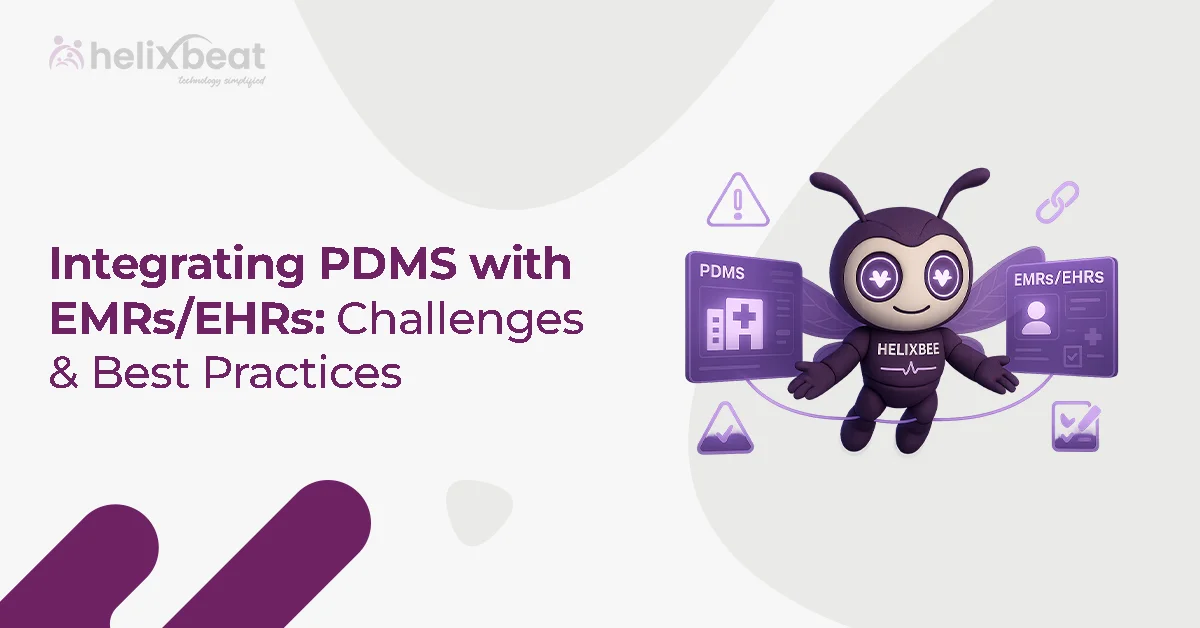It starts with a single denied claim. Then another. Soon, the billing team is drowning in paperwork, chasing down codes, and making endless calls to insurance companies—all while providers struggle to focus on what truly matters: patient care. For many healthcare organizations, this is the daily grind of revenue cycle management. The process feels broken, fragmented, and outdated. Information sits in silos, and systems don’t talk to each other. That’s where the frustration builds—and revenue leaks. But it doesn’t have to be this way.
Imagine a world where data flows seamlessly from patient intake to final payment, claims are processed quickly and accurately, and endless administrative tasks don’t burden staff. This isn’t just wishful thinking—it’s the power of FHIR for RCM. By integrating Fast Healthcare Interoperability Resources into RCM workflows, healthcare organizations are discovering a more innovative, faster, and more connected way to manage revenue.
Let’s dive into how it works—and why now is the time to act.

Table of Contents
Understanding Efficiency and Its Critical Role in Healthcare
Efficiency in healthcare revenue management is crucial. According to a 2023 report by the Healthcare Financial Management Association (HFMA), the average claim denial rate in the U.S. hovers around 9-10%, with some specialities seeing denial rates as high as 15-20%. Denied claims cost providers billions annually and delay payments by an average of 30 to 45 days. Moreover, manual administrative tasks consume up to 30% of healthcare workers’ time, contributing to burnout and increased operational costs. Studies have shown that every 1% improvement in clean claim rates can translate into millions of dollars saved annually for large hospital systems.
The inefficiencies in RCM hurt the bottom line and impact patient satisfaction. Billing errors and delays lead to confusion and mistrust, undermining the patient-provider relationship.
Understanding RCM in a Modern Context
At its core, Revenue Cycle Management (RCM) refers to the administrative and clinical functions that contribute to capturing, managing, and collecting patient service revenue. This includes patient registration and eligibility verification, billing, coding, claims processing, and payment posting.
However, traditional RCM processes are often hampered by siloed data systems, manual workflows, and a lack of real-time visibility—all of which can delay payments, increase denials, and reduce financial performance.
That’s where FHIR for RCM comes into play.
What is FHIR?
FHIR (Fast Healthcare Interoperability Resources) is a standard developed by HL7 for electronically exchanging healthcare information. Designed to enable seamless data sharing across platforms and providers, FHIR simplifies how systems communicate, making it ideal for integrating clinical and financial workflows.
With FHIR, information such as patient records, lab results, and even billing data can be accessed securely and in real-time across disparate systems—reducing redundancy and eliminating the need for manual data entry.
Challenges faced by healthcare providers without RCM integration with FHIR
The healthcare revenue cycle is notoriously complex—and without FHIR integration, the problems multiply:
- Siloed Data: Clinical systems don’t always communicate with billing platforms. This causes inconsistencies, delays, and missed opportunities for clean claims.
- High Denial Rates: Manual entry often leads to coding errors, incomplete documentation, or missed payer rules, resulting in denied or delayed claims.
- Lack of Real-Time Insights: Traditional RCM systems operate in lag. There’s little visibility into where a claim stands or why it’s been delayed.
- Increased Administrative Burden: Without automation, staff must manually reconcile data across systems, increasing workload and burnout.
- Compliance Risks: Manual processes can lead to HIPAA violations or non-compliance with payer requirements.
By implementing FHIR for RCM, providers can finally eliminate these barriers and move toward a real-time, interoperable, intelligent revenue cycle.
Why FHIR for RCM is a Game Changer
FHIR for RCM addresses these challenges head-on—bridging clinical and financial systems to bring speed, accuracy, and intelligence to every step of the revenue cycle. Here’s how it transforms into efficiency:
1. Real-Time Eligibility Verification
Verifying insurance eligibility is one of the front desk’s most critical—and time-consuming—tasks. Traditionally, it involves logging into payer portals, making phone calls, and relying on outdated information.
With FHIR for RCM, eligibility verification becomes instantaneous. Using FHIR APIs, patient insurance details are pulled and confirmed in real-time from payer systems, reducing manual workload and avoiding eligibility-based denials before they happen.
Result: Faster check-ins, fewer surprises, and cleaner claims from day one.
2. Faster, Cleaner Claims
Claim generation shouldn’t feel like assembling a puzzle from incomplete pieces. However, for many billing teams, missing or inconsistent data causes frequent delays and errors.
FHIR for RCM enables systems to automatically extract complete, structured data from EHRs and other clinical platforms. This ensures that every claim is built on accurate, validated information—fully aligned with payer rules and coding standards.
Result: Reduced rework, improved clean claim rate, and faster reimbursement.
3. Smarter Denials Management
Denied claims are a major drain on time and resources. The worst part? Most are preventable. By integrating FHIR for RCM, systems can detect potential errors or missing data in real time—before a claim is even submitted. Automated checks flag issues early, enabling billing teams to fix problems instantly. And if a denial still occurs, FHIR-connected platforms streamline appeals by providing the correct data instantly.
Result: Lower denial rates, faster resolutions, and fewer revenue losses.
4. Automated Payment Posting
Manually matching payments to claims is not only tedious—it’s error-prone. When remittances don’t reconcile cleanly, it causes downstream confusion in accounts receivable.
With FHIR for RCM, payers’ remittance data is automatically matched to the corresponding claims. This closes the loop between services rendered and payments received, ensuring that books are accurate, up-to-date, and audit-ready.
Result: Faster reconciliation, cleaner books, and less manual intervention.
5. Improved Patient Experience
Revenue cycle inefficiencies don’t just affect back-office teams—they frustrate patients, too. Errors in billing, delays in coverage verification, and unexpected out-of-pocket costs erode trust in the healthcare system.
FHIR for RCM brings much-needed transparency and accuracy to the billing process. Patients receive timely, accurate statements, coverage is confirmed quickly, and billing issues are resolved faster.
Result: Higher patient satisfaction, better communication, and a more professional financial experience.
6. Analytics and KPI Monitoring
In today’s value-driven healthcare landscape, you can’t improve what you don’t measure. Yet many RCM teams lack real-time insight into key performance indicators (KPIs) like denial rates, days in A/R, or payment cycle times.
FHIR for RCM changes by feeding clean, connected data into advanced dashboards and reporting tools. Because all systems are interoperable, organizations can track metrics in real-time and drill down into performance drivers.
Result: Better decisions, faster interventions, and data-backed strategy execution.
How HelixBeat Leverages FHIR for RCM Excellence
At HelixBeat, we’ve embraced the future of healthcare RCM by embedding FHIR standards into every layer of our process. We don’t just process claims—we optimize them using real-time data, intelligent automation, and best-in-class interoperability.
We call this solution FUSION—our proprietary FHIR product designed to unify fragmented systems and maximize efficiency across the revenue cycle.
Here’s how FUSION powers every phase of RCM:
- Patient Registration & Eligibility: Real-time insurance verification ensures cleaner claims from day one.
- Medical Coding & Billing: FHIR-connected tools reduce coding errors and automate claim preparation.
- Claims Management: Seamless payer connections enable faster submissions, proactive follow-ups, and improved denial handling.
- Accounts Receivable: Smart workflows prioritize outstanding claims and improve cash recovery.
- Payment Posting & Reporting: Instant reconciliation and real-time visibility into revenue performance.
- Compliance & Analytics: Built-in compliance checks, audits, and customizable dashboards powered by FHIR data streams.
By embedding FUSION into every RCM touchpoint, HelixBeat helps providers minimize revenue leakage, boost performance, and stay focused on what matters most—quality care.
Where to Begin: Steps to Implement FHIR for RCM
If you’re considering implementing FHIR for RCM, here’s how to start:
1. Evaluate Your Current RCM Workflow
Understand where data silos, delays, and inefficiencies exist. Map your current patient-to-payment journey.
2. Assess System Compatibility
Ensure your EHR, billing, and practice management systems are compatible with FHIR or can integrate with middleware that supports FHIR standards.
3. Partner with a FHIR-Savvy RCM Provider
HelixBeat is already ahead of the curve with integrated FHIR for RCM solutions. Partnering with us gives you access to proven technology, expert support, and scalable solutions.
4. Develop a Pilot Plan
Start with a pilot project—perhaps integrating FHIR for eligibility verification or payment posting—and measure its impact on efficiency and cash flow.
5. Monitor, Optimize, and Expand
Use real-time dashboards and analytics to track your RCM KPIs. As your confidence grows, scale up FHIR integration across the entire revenue cycle.
Conclusion
In the high-stakes world of healthcare finance, efficiency isn’t a luxury—it’s a necessity. Every denied claim, every data mismatch, and every manual task chips away at your revenue and your team’s productivity. But it doesn’t have to be this way.
With FHIR for RCM, healthcare organizations are entering a new era—where systems talk to each other, billing is accurate and instant, and the revenue cycle becomes a strategic advantage rather than a constant headache.
At HelixBeat, we believe in empowering providers with technology that works for them, not against them. By integrating FHIR for RCM across your operations, we help you save time, reduce costs, improve cash flow, and deliver better care—without compromise.
Ready to streamline your revenue cycle and take control of your financial future? Let’s begin.
People also asking
What is FHIR for RCM and how does it improve revenue cycle management?
FHIR for RCM is a standard that enables seamless data exchange between healthcare and billing systems, improving accuracy and speed in revenue management.
How does integrating FHIR reduce claim denial rates in healthcare organizations?
FHIR helps identify errors early and ensures complete, accurate claims, significantly lowering denial rates.
What are the key benefits of using FHIR in healthcare revenue cycle workflows?
Benefits include faster claims processing, real-time eligibility checks, reduced manual tasks, and better financial outcomes.
How does FHIR enable real-time insurance eligibility verification?
FHIR APIs connect directly to payer systems, verifying insurance instantly and preventing eligibility-related denials.
What challenges do healthcare providers face without FHIR integration in RCM?
Without FHIR, providers deal with siloed data, manual errors, delayed claims, and increased administrative burden.
How can healthcare organizations start implementing FHIR for RCM?
Start by assessing current workflows, ensuring system compatibility, and partnering with FHIR-savvy RCM providers.
What impact does FHIR for RCM have on patient experience and satisfaction?
FHIR improves billing transparency, speeds up claims, and reduces billing errors, leading to higher patient trust and satisfaction.














